Greetings, fellow earthlings. I have been running around Monterrey, Mexico, eating and drinking everything in sight. And I’m gonna keep the party going as I reenter the SoCal atmosphere, because this week our food team published their guide to the 101 Best Restaurants in L.A. I’m Carolina A. Miranda, art and design columnist at the Los Angeles Times, and I come bearing essential arts and tacos dorados:
Getting monumental
Wandering the streets of Monterrey’s Barrio Antiguo (the old colonial district), I was struck by a series of plaques commemorating popular ghost tales and supernatural legends.
One tells the story of an enigmatic doll with an uncanny smile that was found in a box, along with a letter in a language no one could decipher. Another tells the story of a woman who was followed by the town priest into a cemetery — and when he arrived, he found only a tomb with her name. Yet another marks the tale of a bishop who mysteriously appeared to pay a poor family’s debt then disappeared, never to be seen again.
I was intrigued by this not only because I grew up with plenty of ghost stories. (One of my Peruvian aunts was renowned for her premonitions of death.) But because, at a moment in which monument makers in the United States are reconsidering the ways in which monuments are erected and to whom, it represents an intriguing way of publicly marking intangible heritage such as folk tales.
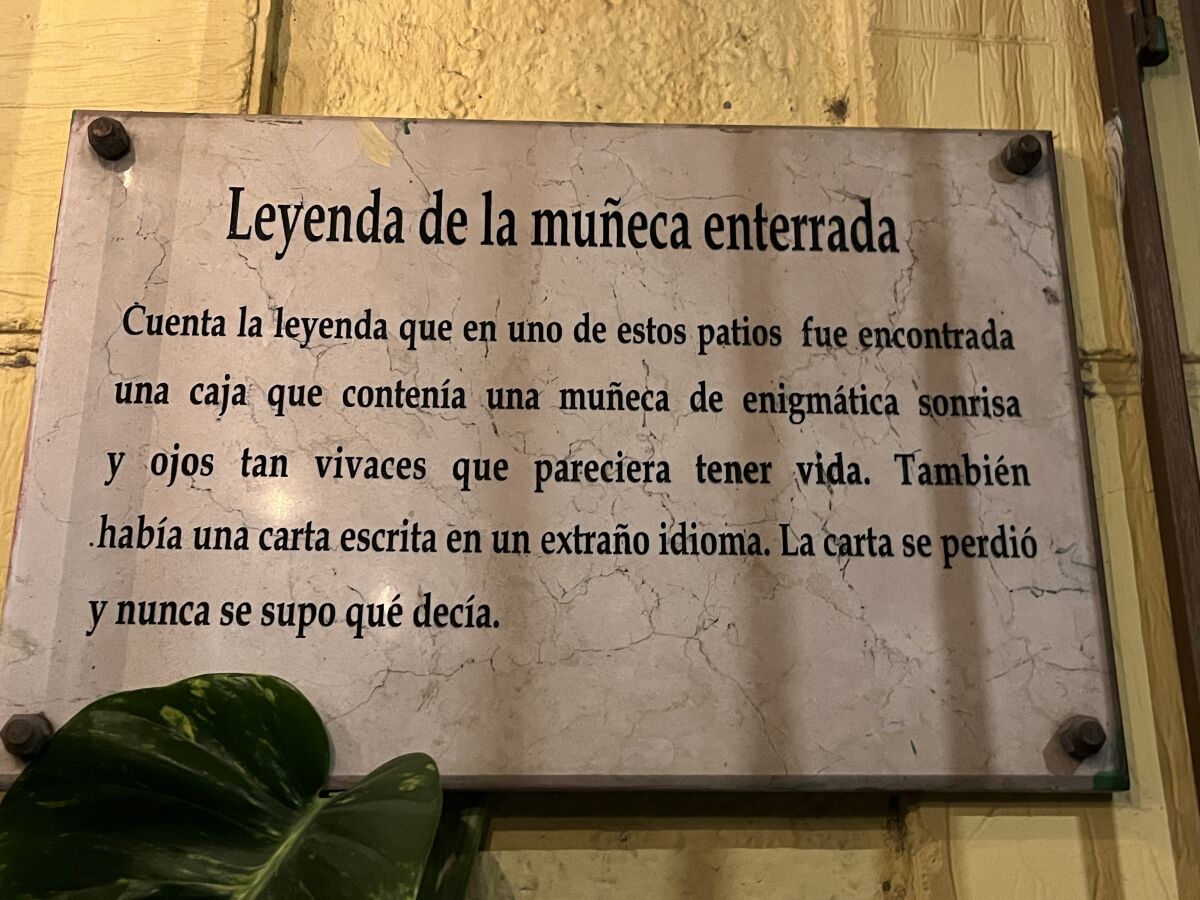
A plaque in Monterrey’s Barrio Antiguo recounts a folk tale about a freaky doll.
(Carolina A. Miranda / Los Angeles Times)
All of this was on my mind as I popped into the Museo de Arte Contemporáneo de Monterrey (known as MARCO) to check out a show of work by the Mexican sculptor Helen Escobedo. The artist, who died in 2010 at the age of 76, is perhaps best known for her monumental public sculptures and installations. This includes the nearly 50-foot-long “Coatl,” 1980, composed of a colorful series of torquing frames, that is permanently installed in the sculpture garden at the Universidad Nacional Autónoma de México in Mexico City.
“Helen Escobedo: Total Environments,” as the MARCO show is titled, covers the breadth of her work: from her early monumental pieces, fabricated in materials like steel, to later works that embodied a more transient materiality, such as mesh and detritus. “Los Mojados,” made in the last year of her life, reflects on the crisis along the border and is made from a simple arrangement of translucent raincoats placed on gently trembling wires. It is unnervingly spectral.
Newsletter
Your essential guide to the arts in L.A.
Get Carolina A. Miranda’s weekly newsletter for what’s happening, plus openings, critics’ picks and more.
You may occasionally receive promotional content from the Los Angeles Times.
But I found myself reveling in a series of wry collages that Escobedo made in the early ’80s of imagined monuments. This included monuments to breast milk and childhood. A monument to classicism featured the giant head of an ancient Greek sculpture in a pubic plaza (in proportions suggestive of the massive heads of the Olmec). Among my favorites: her monument to the cigarette, featuring a single smoke standing like an obelisk in a city street, recalling all the loosies I bought in college, and another to the “gran taco” — because if there’s anything that Netflix’s “Taco Chronicles” has proven over and over again, it’s that poetry is found in a tortilla.
I’m especially intrigued by the humor with which Escobedo approached the subject. Monuments can be dead serious and dead earnest, since so many of them commemorate war and death. She imagined a world in which we built fewer monuments to men and more to concepts that give us pleasure, nourishment, joy.
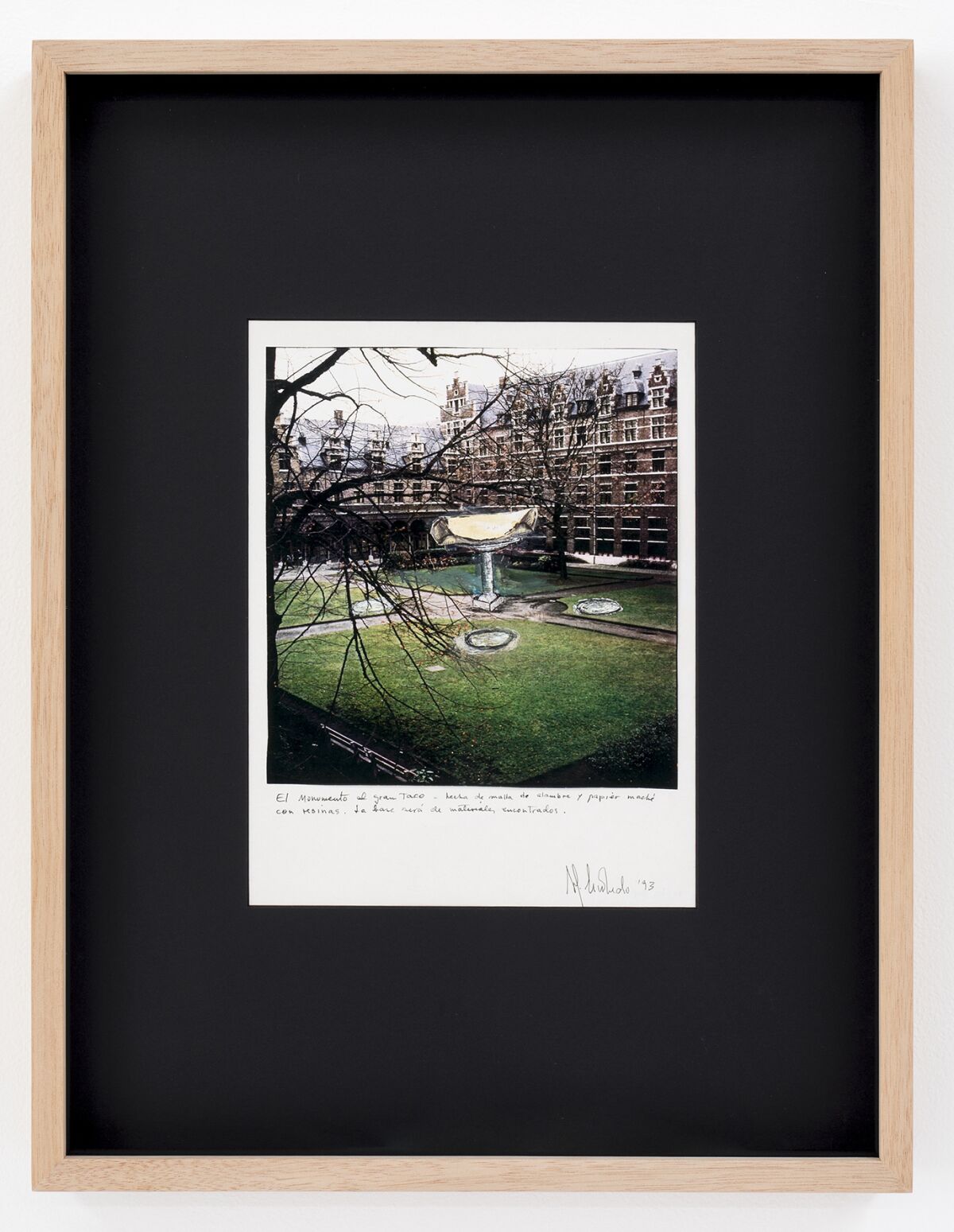
Helen Escobedo, “El monumento al gran taco,” 1993.
(Ramiro Chaves / Fondo Helen Escobedo / Proytectos Monclova)
It’s not a concept without precedent.
In a 1989 book titled “Mexican Monuments: Strange Encounters,” published in collaboration with photographer Paolo Gori, Escobedo offers an informal study of Mexican monuments. There are taxonomies of the great civic markers: heroic figures on plinths and plentiful giant heads. But also receiving ample space in the book are monuments that lean into the popular and the strange — such as a statuary tribute to the bandit Jesús Malverde (a patron saint of narco traffickers) in Chihuahua or the monument to an octopus in Veracruz.
Among my favorites is the Cozumel monument featuring a giant shrimp sitting on a structure that resembles a Roman aqueduct. The caption reads: “Delicious with fresh lime juice, superb in bronze.”
The book, like her collages, is rife with deadpan humor. It also offers another way of looking at monuments — one that expands the ways in which we think about the figures we honor within a city’s landscape. “Why not cast a fresh look at all the effigies you have taken for granted within your own vicinity?” she writes in the foreword. “Search for those others, the strange ones that may be there, or sadly, may not.”
The most meaningful monument in the end may be the simple plaque that honors the neighborhood ghost.
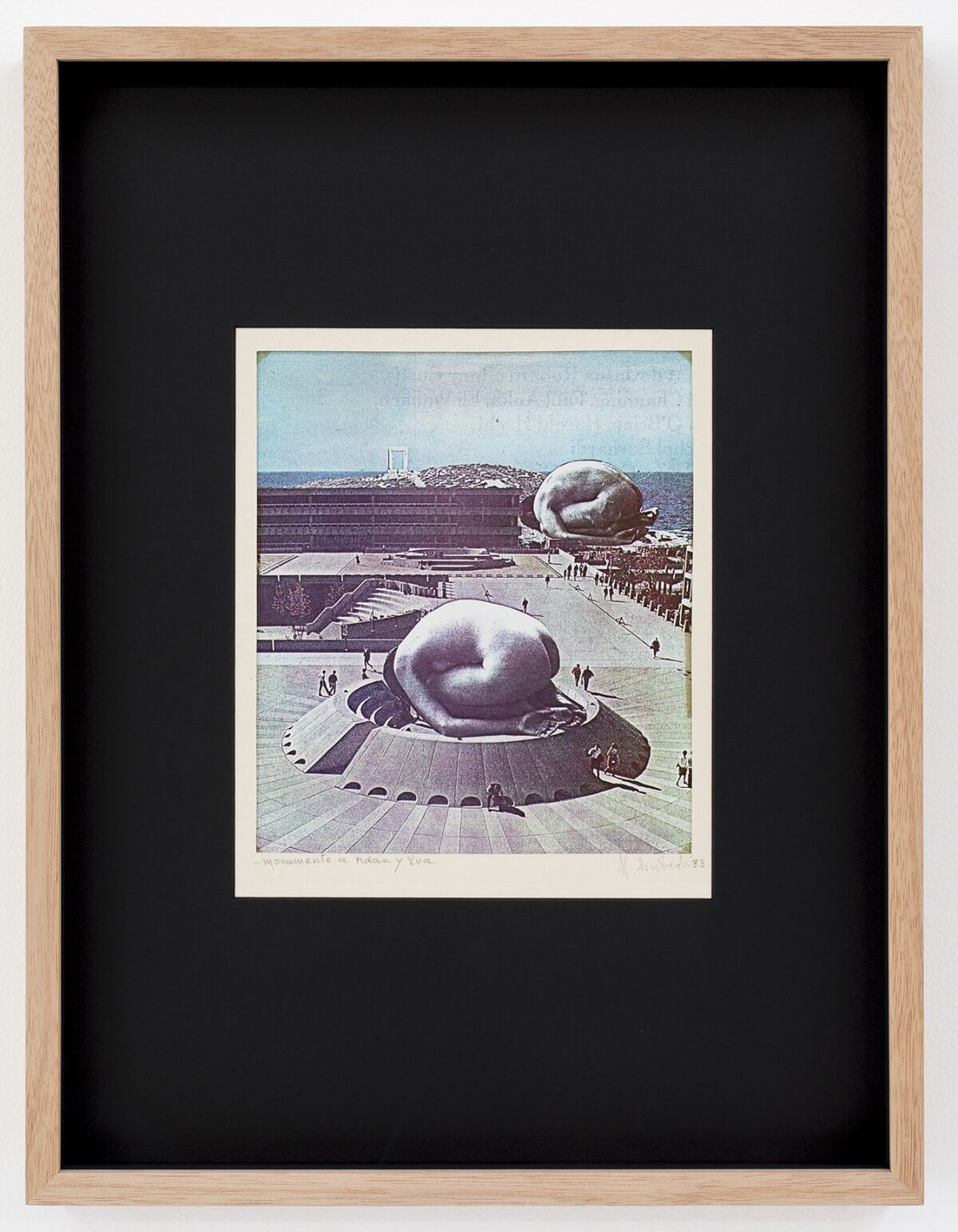
Helen Escobedo, “Monumento a Adán y Eva,” 1983.
(Ramiro Chaves / Fondo Helen Escobedo / Proytectos Monclova)
“Helen Escobedo: Total Environments” is on view at the Museo de Arte Contemporáneo de Monterrey through January; Zuazua and Jardón S/N, City Center, Monterrey, marco.org.mx.
In the galleries
In painter Henry Taylor‘s solo show at MOCA — “Henry Taylor: B Side” — art critic Christopher Knight finds work that “pumps life into the static picture plane.” Taylor is often referred to as a portraitist, since people are his most frequent subject, but Knight sees something deeper in his work: “He approaches painting as a social endeavor — active representation, not passive, which portraiture usually demands.”
ICYMI: my portrait of Taylor in words.
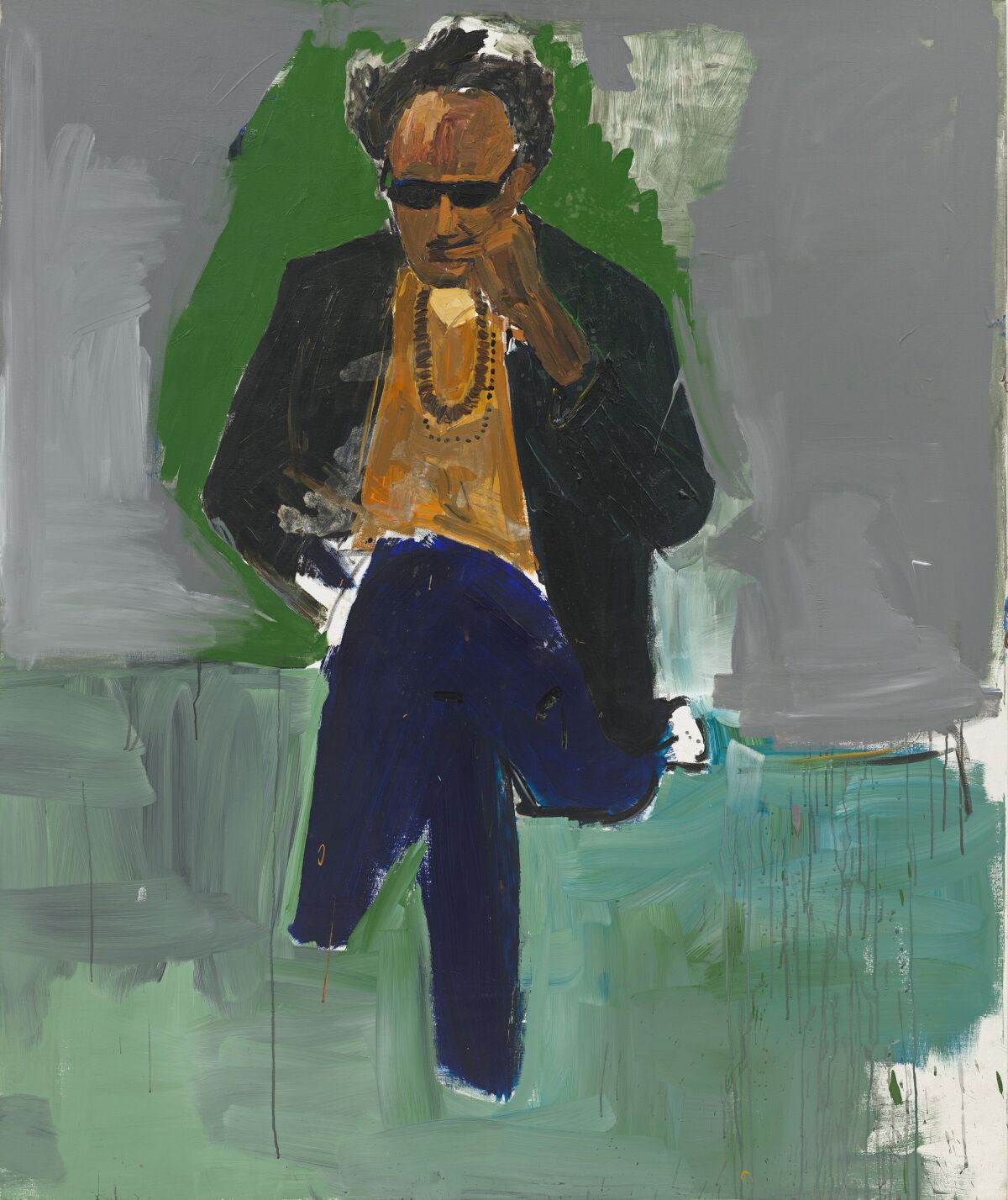
Henry Taylor, “Portrait of Steve Cannon,” 2013.
(Henry Taylor / Hauser & Wirth)
“Gorgeous, funny, lush and disturbing, all at the same time.” Jonathan Griffin considers Kaari Upson‘s recent show at Sprüth Magers — a show that she conceived of in life, but which ultimately ended up being a posthumous exhibition in the wake of her untimely death.
Plus, contributor Samanta Helou Hernandez has a great piece about Maria Maea, an artist who deploys the city’s ubiquitous palms in her work. “Plants have a body, we mimic it, it mimics us,” Maea says of the ways she uses nature to evoke other forms. “I’ll use corn as a spine and people recognize it because we’re mirrors of nature.”
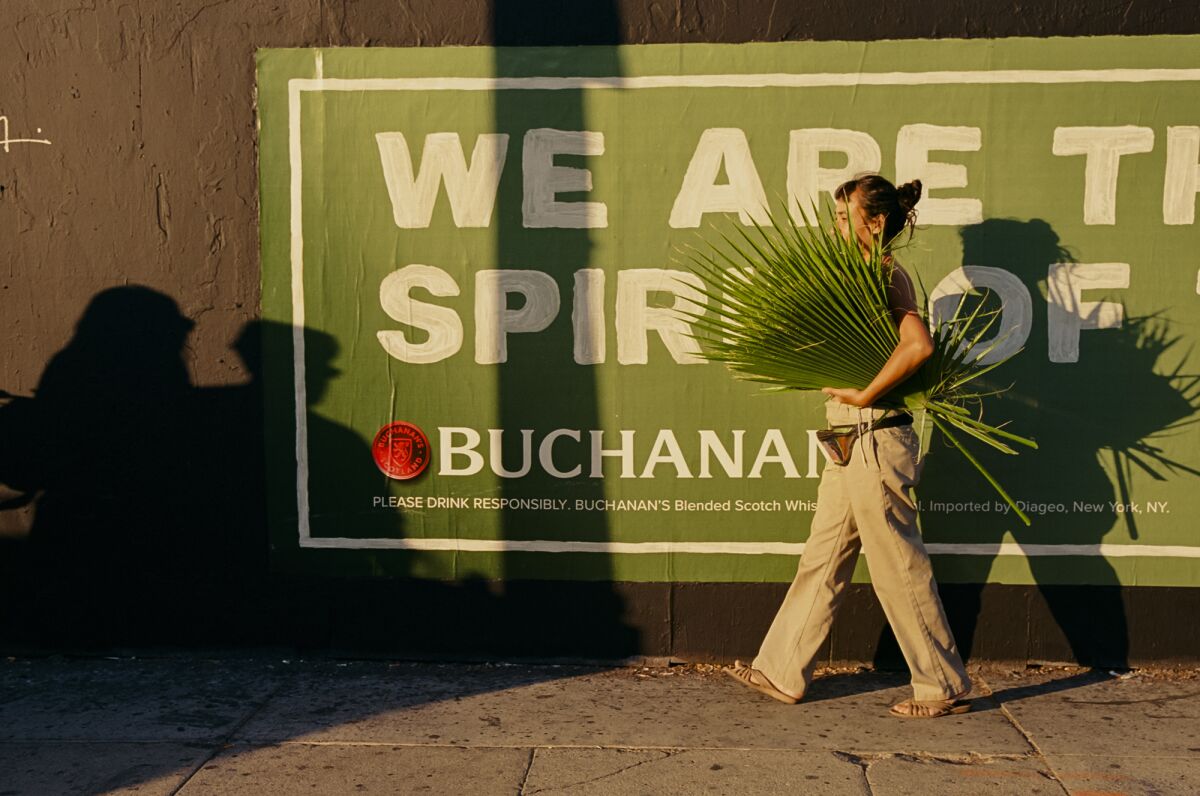
Maria Maea’s process entails taking walks around L.A., locating palm fronds from trees that grow in nondescript parking lots and sidewalk cracks.
(Samanta Helou Hernandez / For The Times)
On and off the stage
Pacific Resident Theatre has resuscitated a one-act play by Edward Albee that is so infrequently produced that theater critic Charles McNulty had never seen or read it prior to this staging. “Fam and Yam” was last produced in L.A. in 1978 as part of a series of one-acts directed by the playwright himself. Now it appears as a prelude to Harold Pinter’s “The Dumb Waiter” — to which it serves as an “intriguing appetizer,” writes McNulty. Why has this play remained under wraps for so long? McNulty has some theories about why that is.
Enjoying this newsletter? Consider subscribing to the Los Angeles Times
Your support helps us deliver the news that matters most. Become a subscriber.
“KPOP,” which made history on Broadway as the first musical centered on Korean pop culture, will close after just 17 regular performances. The Times’ Ashley Lee speaks with composer Helen Park, book writer Jason Kim and producers Tim Forbes and Joey Parnes about what they think went wrong. “Whether we like it or not,” says Park, “telling a contemporary Asian story is still a risk.”
The story of singer Pat Benatar and musician-songwriter Neil Giraldo‘s romance served as a point of inspiration for a jukebox musical titled “Invincible,” on view at the Wallis, which is also inspired by Shakespeare’s “Romeo and Juliet,” as well as another unofficial jukebox musical, written by Bradley Bredeweg, that drew from Benatar’s music for a star-crossed-lovers narrative. The show, reports The Times’ Jessica Gelt, is flush with diverse characters and is set in a post-apocalyptic 21st century Verona. Says Benatar, “It’s kind of cool to be collaborating with Shakespeare.”
Shakespeare may feel differently, however. “Reports of the death of the jukebox form by theater critics are typically more of a wish than an empirical observation,” writes Charles McNulty in his (stinging) review. “But this latest incarnation deserves to topple the entire category.” There are too many biting lines in this review and I can’t put them all here.
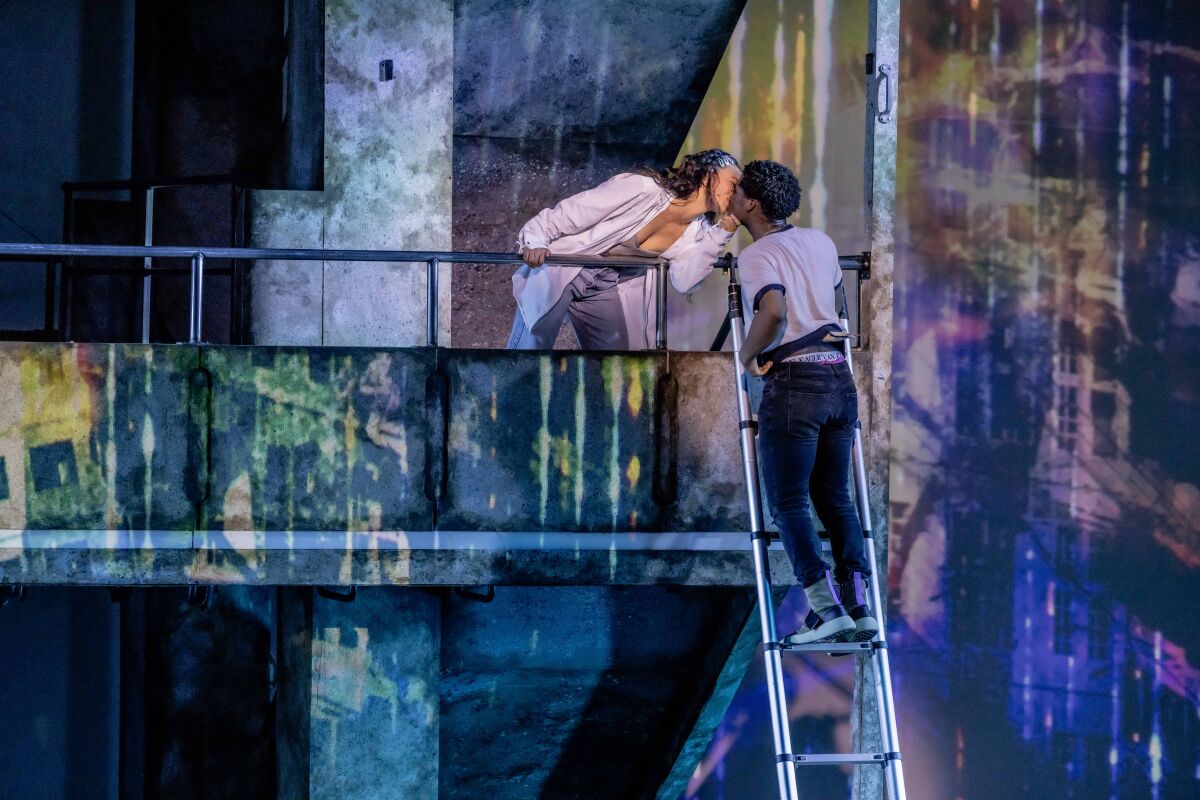
Kay Sibal (Juliet) and Khamary Rose (Romeo) share a kiss in “Invincible.”
(Sean Daniels / DVR Productions)
And because one “Romeo and Juliet“-themed jukebox musical is not enough: The Atlantic’s Spencer Kornhaber writes about Max Martin, the songwriter behind the tunes in the jukebox musical “& Juliet,” which is currently on Broadway. Not to be confused with “The Last Goodbye,” a jukebox musical inspired by “Romeo and Juliet” that features tunes by Jeff Buckley.
ICYMI, McNulty had a great convo with playwright Lynn Nottage last week, whose comedy “Clyde’s” is currently on the stage at the Mark Taper. Among other things, she talks about all the work by Black playwrights that has come in her wake: “The one thing I think we still need to move toward is to stop making plays that feel like they’re designed for the white gaze.”
Classical notes
L.A. Phil musical director Gustavo Dudamel returned to his native Venezuela for the first time in six years and his hometown of Barquisimeto for the first time in 11 years to lead rehearsals for the country’s famed youth music program, El Sistema. Times classical music critic Mark Swed spoke to him about the experience of returning. It was important, he says, to go back, so that “the children had to see that I’m there for them, that I’m not only an idea.”
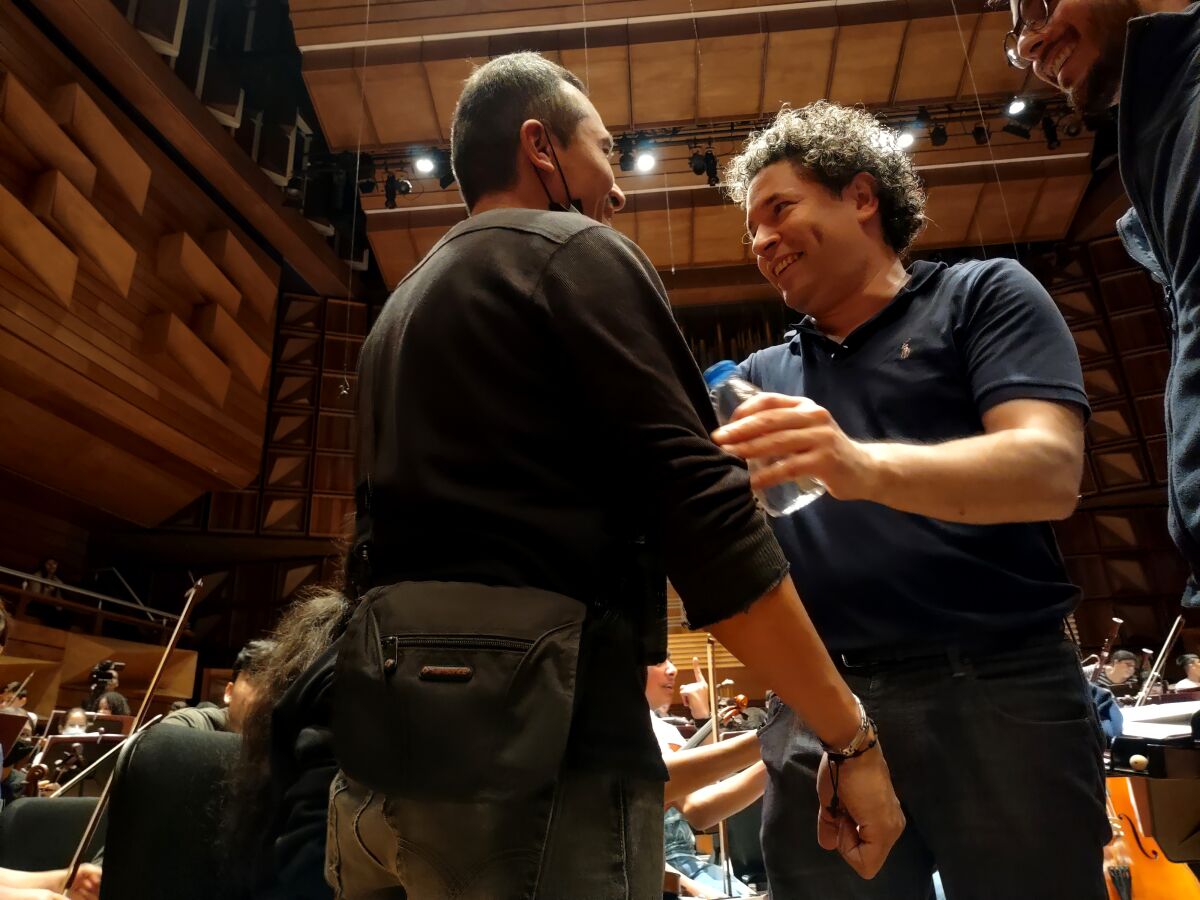
Gustavo Dudamel, right, works with El Sistema youth orchestras in Caracas last month.
(Daniel Vielma)
Most wonderful time of the year
This is the end, beautiful friend — of 2022. Which means it’s time to bring on the listicles!!! Art critic Christopher Knight rounds up the year’s biggest art stories and museum blunders, while theater critic Charles McNulty reviewed this most challenging comeback year for live performance. Classical music critic Mark Swed has the classical year in review (it’s all about resilience), culture writer Deborah Vankin rounds up the works that have been most meaningful to her, and a panel of four book critics weigh in on the year’s reads.
Find the entire package at this link, with additional lists for film, TV and music (with playlists!).

(Illustration by Mel Cerri / For The Times)
I couldn’t pull it together to do a year-end list because I am me. But fellow architecture writers Mark Lamster (Dallas Morning News) and Alexandra Lange (author of the mall history “Meet Me by the Fountain”) invited me to pitch in on their highly unofficial architecture and design awards for 2022. It features commendations such as the Golden Carbuncle Trophy and a Rivers of Babylon Plaque — in other words, it’s bigger than the Pritzker.
Annals of the Latin American bizarre
I wrote an appreciation of HBO’s “Los Espookys” after its cancellation last week, an unclassifiable show that I have categorized as “‘Scooby-Doo’ as written by Jorge Luis Borges and directed by Pedro Almodóvar.”
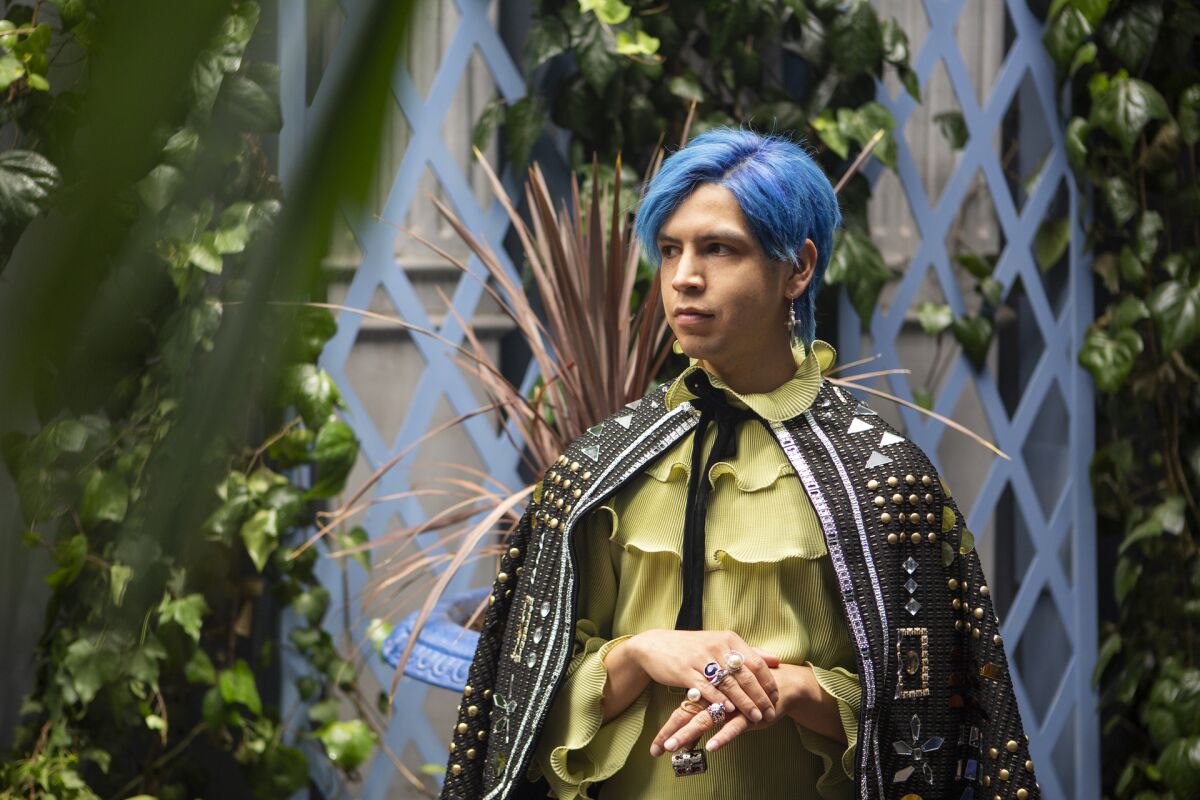
Julio Torres as the otherworldly Andrés in a scene from “Los Espookys.”
(Diego Araya Corvalan / HBO)
New York Times dance critic Gia Kourlas writes about the virality of the Wednesday dance — inspired by Jenna Ortega‘s freaky jig in the “Addams Family” spinoff “Wednesday” on Netflix.
Moves
The Natural History Museum of Los Angeles County has released updated renderings for its ongoing expansion and renovation, featuring a new entrance and a new indoor-outdoor wing by L.A. firm Frederick Fisher & Partners.
Penske Media has acquired Artforum magazine, adding it to an existing stable of art publications that includes Art in America and ARTnews.
Sculptor Veronica Ryan, known for works that employ humble materials and that nod to her Caribbean roots, has been named the recipient of this year’s Turner Prize.
Kojin Karatani, a philosopher known for his critiques of capitalism and an important literary critic in his native Japan, is the recipient of the $1-million Berggruen Prize.
Passages
Aline Kominsky-Crumb, an artist who injected a dark humor and an empowered, raunchy female sexuality to comics, has died at 74.
In other news
— New York’s Metropolitan Opera is contending with a cyberattack that has kept its computer systems down for more than three days.
— The School of the Art Institute of Chicago has rescinded the honorary degree it awarded musician Kanye West (now known as Ye) in 2015.
— ICYMI, The Times’ August Brown went deep on how Ye went from respected artist and fashion designer to losing endorsements and other partnerships over his racist and antisemitic rants and his association with neofascist Nick Fuentes.
— In Munich, an exhibition explores the richness of queer life in Germany in the early 20th century — and the ways in which the Nazis attempted to stamp it out.
— Rosanna McLaughlin has a good essay in ArtReview about “Death of an Artist,” the recent podcast about Ana Mendieta‘s life and death.
— Curbed’s Alissa Walker looks back at Mayor Eric Garcetti‘s term using the health of the city’s sidewalks as a measure. The temperature? It’s not good.
— All the attention is on San Francisco’s $1.7-million toilet, but have a look at these space-age public restrooms from JCDecaux that the city is installing near the Embarcadero. Take me to my ship!
— I dug this New Yorker story about the history of the multiverse — an intriguing narrative device that also allows film studios to endlessly recycle characters and plot devices.
And last but not least …
How to get a COVID-19 booster in California. Seriously, folks, it’s gnaaaaarly out there.
Stay connected with us on social media platform for instant update click here to join our Twitter, & Facebook
We are now on Telegram. Click here to join our channel (@TechiUpdate) and stay updated with the latest Technology headlines.
For all the latest Art-Culture News Click Here
